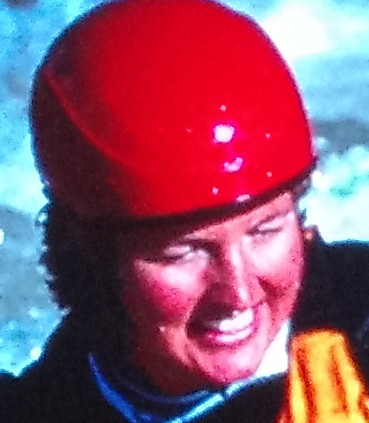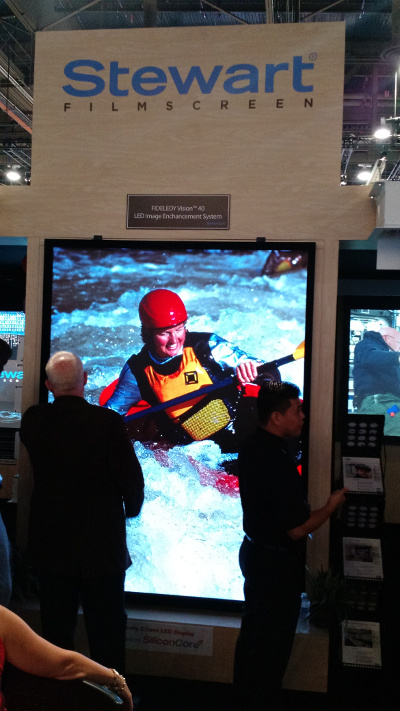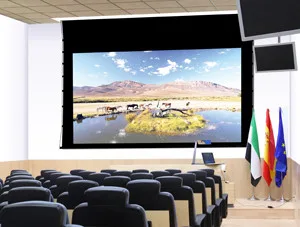Stewart Filmscreen introduced three new products at InfoComm this year. The first one we saw was the new Torrent ElectriScreen. Designed with corporate campuses, educational institutions, and houses of worship in mind, it gives installers and consultants the option of an elegant recessed roller screen with an image width up to 17 feet (5.1m) wide.
The Torrent has a streamlined case with a beautiful finish, designed to be only 9 ¼ inches (235mm) tall by 12 ½ (318mm) inches deep—considerably smaller than competitors’ offerings and preceding Stewart units of this scale. The small case height and simple four-point mounting system allow the Torrent to fit a wider range of ceiling depths, reducing the workload on integrators. Torrent eliminates side access covers through use of offset interior endplates. Unlike many competing offerings, Stewart ensures a substantially reinforced roller system to handle traditional aspect ratios, but also can customize Torrent with plenty of extra black drop above the image area for rooms with high ceilings.
The Stealth XM screen was designed for large-scale applications where the screen must be completely concealed when not in use. Integrators can choose from a variety of Stewart’s front- or rear-projection materials for the ultimate flexibility. Like the Torrent, the Stealth XM relocates the controls inside the case for easy and reliable access. All functions, including screen operation, control system, and mounting protocol, are accessible via the door opening, instead of access panels. The Stealth XM trapdoor offers a hinge-less self-finishing appearance for streamlined installation. Thanks to the new roller tube design, the Stealth XM is now available in image widths up to 14 feet (4.25m), significantly wider than previous trapdoor electric screen designs.
Stewart Filmscreen also upgraded its newest diffusion screen material—Fideledy Vision 40, at InfoComm, which we first reported on from ISE. This is not a projection screen but rather a surface for use with LED video walls for digital signage, broadcast, and staging applications. The idea is to use this material to diffuse the image of a 2.6mm pitch LED module so that it looks more like a 1.2 mm LED image – but at much lower cost.


The new Vision 40 screen material was reformulated to lower the transmission level and improve contrast to make it perform better in an ambient environment. This screen is not laminated to the LED wall the way others do it, but rather is placed a short distance above the LED surface. Side thumb screws allow for tensioning the film and adjusting the separation – which can change the sharpness of the image. The film was demonstrated in the booth using an LED wall from SiliconCore. Notice the lack of pixelization on this 2.6 mm pitch LED in the close up image. – CC

